In the realm of drilling operations, the unsung hero often overshadowed by towering rigs and cutting-edge technology is the rotary drill bit. This article delves into the intricacies of these small but mighty components, exploring their evolution, design nuances, and the groundbreaking innovations propelling drilling efficiency to new heights.
Evolution of Rotary Drill Bits
Historical Development
Early Drill Bit Designs
The inception of rotary drill bits traces back to rudimentary designs, where simplicity met necessity. Stone and metal served as primary materials, offering basic functionality for early drilling endeavours.
Modern Innovations
Cutting-edge Materials
Today’s drill bits are crafted from cutting-edge materials such as tungsten carbide and diamond composites. These materials withstand extreme conditions, ensuring optimal performance in demanding drilling environments.
Precision engineering, aided by computer-controlled processes, has ushered in an era where each drill bit is a testament to meticulous craftsmanship.
Anatomy of a Rotary Drill Bit
Components and Their Functions
Cutter Blades
At the heart of every rotary drill bit are the cutter blades. These components, often equipped with diamond cutters, slice through rock formations with surgical precision, minimising friction and heat generation.
Bearings and Seals
Efficient drilling requires smooth rotation, achieved through high-quality bearings and seals. These components reduce friction, ensuring the longevity of the drill bit in harsh drilling conditions.
Connection Interfaces
The drill bit’s connection interfaces are vital in transmitting power from the rig to the bit. Customisable interfaces allow for adaptability to various drilling systems.
Design Considerations
Balancing Speed and Durability
A delicate balance exists between drilling speed and bit durability. Engineers meticulously design bits to optimise cutting efficiency while maintaining structural integrity, a critical factor in drilling performance.
Customisation for Specific Applications
Not all drilling operations are the same. Tailoring drill bit designs to specific applications, whether it’s soft sediment or hard rock, ensures maximum effectiveness in diverse geological settings.
Advantages of Rotary Drill Bits
Enhanced Penetration Rates
Impact of Cutter Geometry
Cutter geometry directly influences penetration rates. Innovative designs incorporating varied cutter shapes and arrangements maximise drilling efficiency by reducing resistance and enhancing the rate of penetration.
Optimal RPM for Efficient Drilling
Determining the optimal revolutions per minute (RPM) is a key consideration. Striking the right balance ensures that the drill bit operates at peak efficiency, minimising energy consumption and maximising drilling speed.
Extended Bit Lifespan
Wear-resistant Coatings
Wear-resistant coatings, often using advanced materials like PDC, shield the drill bit from abrasion. This extends the bit’s lifespan, reducing downtime and enhancing overall drilling productivity.
Heat Dissipation Strategies
Intense drilling generates heat. Smart design strategies, such as incorporating cooling channels and heat-resistant materials, preventing overheating, and preserving the integrity of the drill bit.
Applications and Industries
Oil and Gas Exploration
Deep Drilling Challenges
Rotary drill bits prove their mettle in oil and gas exploration, where depths are vast and challenges are formidable. Their ability to withstand intense pressure and temperatures is paramount for successful extraction.
High-Pressure Environments
Drilling in high-pressure environments demands resilience. Rotary drill bit, equipped with advanced materials and design features, thrives in these conditions, ensuring reliable performance in deep wells.
Geothermal Drilling
Harnessing Earth’s Heat
Rotary drill bits are instrumental in reaching the depths where heat from the Earth’s core can be harnessed for geothermal energy extraction. Their efficiency in diverse geological formations makes them indispensable in geothermal drilling.
Geothermal Energy Extraction
As the world pivots towards sustainable energy sources, geothermal drilling gains prominence. Rotary drill bits are pivotal in extracting geothermal energy, contributing to the global shift towards cleaner, renewable energy.
Future Trends and Innovations
Smart Drill Bit Technologies
Integration of Sensors
The future of rotary drill bits lies in smart technologies. Integration of sensors allows real-time monitoring, providing valuable data for performance optimisation and predictive maintenance, reducing downtime.
Real-time Data Analysis for Performance Optimization
Analysing real-time data from drill bit sensors enables operators to make informed decisions. This not only enhances drilling efficiency but also contributes to overall operational safety and cost-effectiveness.
Sustainable Drill Bit Practices
Recycling Materials
As environmental consciousness grows, the industry is moving towards sustainable practices. Recycling materials used in drill bits reduces waste and lessens the environmental impact of drilling operations.
Reducing Environmental Footprint
Efforts to minimise the environmental footprint of drilling operations are underway. Innovations in sustainable materials and practices aim to balance meeting energy demands and preserving the planet.




